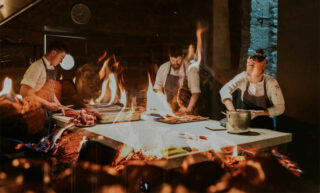The Spirit of Spontaneity
’Tis the season yet again – Christmas markets are in full swing, the smell of Maroni is in the air and Glühwein is consumed by the bucket. And, of course, there’s the obligatory toast on Silvester (New Year’s Eve): If you want to go fancy, there’s always champagne, the undisputed king of sparkly – although there are plenty of equally good crémants and cavas made in the same way. Produced slightly differently but just as festive (and quite affordable), prosecco is now Italy’s biggest oenological success story alongside pinot grigio. But this year, we’d like to suggest a pét-nat. Pét-what, you might ask?
Let’s start with the name. Short for pétillant naturel, or “naturally sparkling,” pét-nats are made without a second fermentation in the bottle, the step that gives champagne, crémant and cava its bubbles. Catering to a growing movement that prefers “simpler” wines, it relies instead on spontaneous fermentation.
The conventional practice as used in champagne, called the “methode traditionelle,” sees a base wine bottled with a yeast solution (the liqueur de tirage), which adds carbon dioxide as a byproduct of fermentation; the dead yeast cells – responsible for the toasty flavors – are then removed (the degorgement) before adding more base wine and a bit of sugar solution (the liqueur d’expedition), which gives the sparkler its characteristic flavor profile.
Makers of pét-nat take a completely different approach however: Following credo of “nothing added, nothing removed,” liqueur de tirage and liquer d’expedition are anathema. Instead, pét-nat is bottled while still fermenting – the last bit of carbon dioxide can’t escape and dissolves, rendering it sparkling. This sounds easy, but is actually quite complicated. Timing is crucial – wait too long and the wine will be flat, but start too soon and excessive carbon dioxide might blow the cap off – or worse, make the bottle explode.
Back to the roots
These days, pét-nats are very much en vogue, both among natural wine aficionados and the younger generation, with some even considering it a hipster drink. It is however far from a passing fad; in fact, it’s the oldest way of producing sparkling wine, with a tradition that goes back centuries. Also called methode ancestrale, it stems from a time when an early winter
could interrupt fermentation; once spring came and the temperatures rose again, fermentation continued, leaving carbon dioxide in the bottle as bubbles.
Most pét-nats are easy drinking, often fruit-forward, sometimes a bit rustic on the nose and, for the most part, reasonably priced. Coming in white, orange, rosé and red, they can be cloudy or transparent, fruity or restrained – but seldom sweet. Remember the liqueur d’expedition? It’s largely responsible for the sweetness of cava, champagne and crémant, but can’t be found in a pét-nat: nothing added, nothing removed. But as we’ll see, there are exceptions.
Enrico Bachechi, owner of the natural wine shop Vinifero and organizer of an annual pét-nat fair in Vienna, explained that while most pét-nats are made by natural wine makers, strictly speaking anyone could do it, leading to different definitions and practices. “The question for natural winemakers is always whether or not to disgorge. Dead yeast cells and remaining solids from pressing the grapes can potentially lead to the development of stinky compounds, but for purists, removing them is a no-no.”
Claus Preisinger, a vintner om Burgenland, disgorges his “Ancestral,” not so much to get rid of dead yeast but to remove tartrate crystals, which most people don’t like but are otherwise harmless. Although Preisinger is very much on the natural side of the winemaking spectrum, it shows there are shades of grey.
Some vintners stretch the definition, borrowing elements from champagne production. Christoph Hoch’s Kalkspitz is made by adding (finished) reserve to fresh wine before fermenting the mixture a second time. As pét-nat allows for only one fermentation, Kalkspitz doesn’t technically qualify, but on the other hand, Hoch works biodynamically and doesn’t add or remove anything. It’s a favorite among cognoscenti.
Costadilà, a winery in the Veneto, goes one step further, adding the sugar-rich juice of semi-dried grapes to trigger a second fermentation in bottle; as the additive is pure and from certified organic grapes, it remains popular among the natural wine crowd and is called a pét-nat by most.
But regardless of the process, the end result remains a departure from the usual, and an eminently drinkable one at that. Both traditional and hip, ancient yet fresh, why not toast the New Year with something new – after all, spontaneity is the spice of life!
Natural Selection
We asked some of Vienna’s leading sommeliers and wine shops for their favorite pét-nats for the holidays. Prost!
André Drechsel, sommelier, Tian:
Christoph Hoch, Kalkspitz (Kremstal, Austria)
Steve Breitzke, owner/sommelier, MAST Weinbistro:
Judith Beck, Bambule pét-nat pinot noir 2017 (Burgenland, Austria)
Dominik Portune, owner, Vinonudo:
Pranzegg Lagrein, pét-nat rosé (Alto Adige, Italy)
Enrico Bachechi, owner, Vinifero:
Costadilà Bianco 280slm (Veneto, Italy)
Erich Andert, Weinskandal:
Claus Preisinger, Ancestral (Austria)
Author’s choice:
Sextant Julien Altaber, Pétillant naturel l’Ecume (Burgundy, France)
B.O.U.M.
Every June, Enrico Bachechi of the natural wine shop Vinifero organizes a pét-nat fair called B.O.U.M, an acronym for Bubbles Only Using Must. It’s a clear reference to pét-nat’s ethos: nothing added but fresh grape juice, the must. Around 35 producers, mostly from Austria, present their sparklers, allowing shops to place orders for the holidays and wine lovers to celebrate the start of the summer. Ultimately, pét-nat is not just a great alternative to prosecco or champagne on New Year’s Eve, it’s also a refreshing summer drink.
B.O.U.M. 2020 – Jun 5 (tentative) at Glacis Beisl, Breite Gasse 4, 1070 Wien
vinifero.at
A slightly adjusted version of this article has been published in Metropole – Vienna in English, winter 2019/2020 issue 37.





Comments